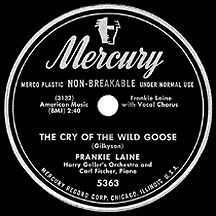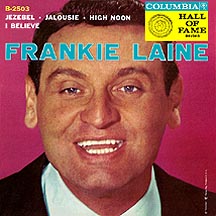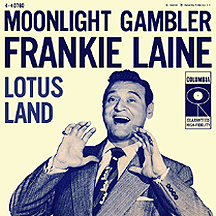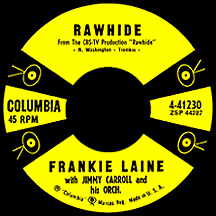FRANKIE LAINE
In the late 1940s, my father was working as a UPS driver on the Hollywood and Beverly Hills routes. One day in 1947 while having a bite to eat after work at a small restaurant in the Hollywood area, there was a man who kept feeding nickels into the jukebox, punching up the same song over and over: 'To spend one night with you in our old rendezvous, and reminisce with you, that's my desire.' After several plays he approached the guy and asked why he kept repeating the same song. The guy said he was the singer, it was his new record and he wanted people to hear it. Unknown to my dad at the time, the man had already been in the entertainment business for about 17 years and was obviously trying every trick, no matter how small, to promote himself. Dad told me that when he started hearing the song on the radio and then later saw its singer, Frankie Laine, on TV, he could only say, "It's that guy!"
That guy later became known as "Mr. Rhythm." Other nicknames, "Old Leather Lungs" and "Mr. Steel Tonsils" were less complimentary, but with no malice intended. He ended up with not one, but two stars on the Hollywood Walk of Fame (one for music, the other for television). How many people can say that? Here was an artist who sang in many styles: pop, jazz, R&B, country, gospel and even a little rock and roll. He was also a dancer who could "cut a rug" nonstop for literally months at a time...no kidding! Born in 1913 and raised in Chicago's Little Italy, Frank Lovecchio's love of music and performing was his first priority. He was destined to do what he loved for more than seven decades.
The future Frankie Laine started as a singer in the choir of the Church of Immaculate Conception when he was in his teens. He was influenced by many of the popular singers of the 1920s, running the gamut from crooner Gene Austin to the great jazz singer Bessie Smith. At 17 he was singing in front of audiences, just a few miles from his home at the Merry Garden Ballroom, a popular North Chicago dance hall that had been open since 1921. Frankie found fame initially not as a singer but as a dancer, competing in dance marathons around the country and doing quite well. At a 1932 marathon in Atlantic City, he and partner Ruth Smith danced for 3,501 hours - almost five months! - and Frankie had energy to spare, often singing for the audience during the hourly breaks in place of resting. An incredible feat, you're thinking? Yet the world record for marathon dancing beats their time by more than two months! Still, Frankie and Ruth split the grand prize of a thousand dollars, a highly desirable amount in the days of the depression.
Still using his given name Lovecchio, about seven years of dancing and singing led to a position with Cleveland's Freddie Carlone band after its vocalist, Perry Como, had moved on to bigger things. Then in 1938 he got a job singing on New York City's WINS radio and that was when, feeling the big time within his grasp, he changed his professional name to Laine. But the Big Apple gig didn't last, and he continued performing wherever there were opportunities, mostly in small clubs, often crossing the country between New York and Los Angeles and points in between, sharpening his songwriting skills along the way. When the clubs weren't calling, he supported himself at a variety of jobs including dance instructor, car salesman, club bouncer and factory worker. This routine went on well into the 1940s.
By 1943 he had settled in Los Angeles and became close friends with Nat "King" Cole at about the time the Alabama-born jazz singer was starting to hit big (The King Cole Trio recorded a song Laine had written, "It Only Happens Once"). He finally made records of his own in 1944 and '45 for the Beltone and Exclusive labels and took advantage of an opportunity to record for Art Rupe's Atlas Records, waxing the Bobby Troup song "Baby, Baby All the Time" in addition to some sides with Oscar Moore and the group that became Johnny Moore's Three Blazers (which included future R&B star Charles Brown). In 1946, Hoagy Carmichael caught Laine's act at an L.A. nightclub, which led to a deal with the recently-established Mercury Records.
Written 16 years earlier, Frankie's recording of "That's My Desire" was a smash in the spring of '47, spending most of the summer in the top ten, fending off a version by Sammy Kaye that was also a hit. R&B singer/piano player Hadda Brooks had been at one of Laine's shows and liked the song, recording a version that went top ten on the Race Records (forerunner of the R&B) charts, but Frankie's "Desire" went even higher than Brooks on that list as well. It had taken more than a decade-and-a-half, but he had finally broken through. Afterwards, the hits came nonstop: "Shine," a standard dating back to 1910, returned him to the top ten in 1948 at about the time Mitch Miller joined Mercury as head of A&R and suggested Laine try a new direction: western-style (but not specifically country) music. "That Lucky Old Sun," penned by Beasley Smith and Haven Gillespie, conjurs images of hard-working old west pioneers and hit number one nationally in September 1949. It was knocked off the top spot two months later by Frankie's "Mule Train," an over-the-top western scenario complete with whip cracks and clippety-clops (the Oscar-nominated Johnny Lange-Hy Heath-Fred Glickman song was featured in the film Singing Guns). He was the hottest act in music at the end of the 1940s thanks to these crowd-pleasing releases, and the tone was set for many imaginative hit songs that would take him through the next decade.
Starting with Make Believe Ballroom in 1949, Laine made many film appearances, mainly performing songs as himself (he had previously dubbed the singing voice of Danny Kaye in the 1946 film The Kid From Brooklyn). His first hit of 1950, "The Cry of the Wild Goose," was a sensation; written by Terry Gilkyson (the folk singer best known for his 1957 hit "Marianne" with The Easy Riders), the song's dramatic imagery took listeners into the skies, as 'My heart knows what the wild goose knows...' became a popular catchphrase and lyrics like '...she'll see a shadow pass overhead, she'll find a feather beside my bed,' while a bit absurd were also enticingly appealing. It was his third number one hit in a span of six months ("Mule Train" and ""Goose" were also a good fit for the style of "Tennessee" Ernie Ford, who covered the songs successfully for the country market). Another 1950 hit, "Swamp Girl," featured a haunting coloratura backing vocal by Loulie Jean Norman, who supplied a similar vocal effect for TV's Star Trek theme in the '60s.
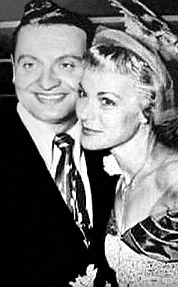
Laine's red-hot music career wasn't the only high point of 1950; his marriage that year to actress Nan Grey (best known for the Oscar-nominated Three Smart Girls in 1936) was extremely successful by show biz standards, lasting until her death in 1993. Also in 1950, Mitch Miller accepted a high-level position with Columbia Records; Frankie joined the label when his Mercury contract expired the following year. He kicked off his Columbia deal with the Wayne Shanklin song "Jezebel," a spanish-flavored number suggesting 'If ever the devil was born without a pair of horns, it was you, Jezebel, it was you!' Coupled with the Chinese-to-English language standard "Rose, Rose, I Love You," it was a huge double-sided 1951 hit. Laine began a popular series of duets with Jo Stafford and found himself well-suited to vocal collaborations, enjoying hits in the next few years with Doris Day and The Four Lads in addition to the juvenile "Tell Me a Story" with the 14-year-old (but much younger-sounding) Jimmy Boyd, considered by some a career low-point...but yet another big hit!
"High Noon (Do Not Forsake Me)," written by Dimitri Tiomkin and Ned Washington for the Oscar-winning High Noon starring Gary Cooper, was performed in the 1952 film by Tex Ritter. It fit right into Frankie Laine's western motif and his version was the bigger hit. In 1953, the inspirational "I Believe" was another of Laine's great hits in America while establishing him as a superstar in England with an all-time record 18 weeks at number one on the U.K. charts, leading to a long run of hits in that country, many of them western-style recordings that were bigger there than in the U.S.
With countless TV appearances under his belt, he became the host of his own Frankie Laine Time on CBS, a summer replacement for Arthur Godfrey and his Friends in 1955 and '56. As rock and roll music was taking hold, "Moonlight Gambler," with his signature western-style arrangement, was a top ten hit but would be his last. Acting assignments came along later in the decade and into the '60s; mostly small character roles in shows like Perry Mason, Rawhide, Bachelor Father and Burke's Law. He was the natural choice to sing the theme for "Rawhide" (another Tiomkin-Washington song), the CBS western series starring Eric Fleming and Clint Eastwood, with those 'rolling, rolling, rolling' lyrics becoming yet another pop culture feather in his cap (or beside his bed if you prefer).
With hit songs harder to come by and acting opportunities scarce, he branched out in the 1960s, harkening back to his earlier car salesman days as owner of a Rambler dealership. The Barry Mann-Cynthia Weil song "Don't Make My Baby Blue," an attempt at a more rock-leaning sound (produced by Terry Melcher and arranged by Jack Nitzsche) was his final Columbia hit in 1963. He moved on to a brief association with Capitol Records and enjoyed a resurgence in his career on the ABC label from 1967 to 1969, scoring several chart singles including the top 40 hits "I'll Take Care of Your Cares" and "Making Memories." A moving performance of a song composed by Marty Robbins, "You Gave Me a Mountain," was a number one Easy Listening hit in March 1969. Another 35 years of concerts, recordings and personal appearances followed, totaling 75 years! The only person I can think of with a longer career in entertainment is Mickey Rooney (with Betty White closing in fast).
NOTABLE SINGLES:
- That's My Desire - 1947
- Mam'selle - 1947
- Shine - 1948
- Ah But it Happens - 1948
- You're All I Want for Christmas - 1948
- That Lucky Old Sun - 1949
- Now That I Need You - 1949
- Mule Train - 1949
- The Cry of the Wild Goose - 1950
- Satan Wears a Satin Gown - 1950
- Swamp Girl - 1950
- Stars and Stripes Forever - 1950
- Music, Maestro, Please /
Dream a Little Dream of Me - 1950 - Metro Polka - 1951
- Jezebel /
Rose, Rose, I Love You - 1951 - Pretty Eyed Baby - 1951
by Jo Stafford and Frankie Laine - The Girl in the Wood - 1951
- Hey, Good Lookin' - 1951
by Frankie Laine and Jo Stafford / - Gambella (The Gamblin' Lady) - 1951
by Jo Stafford and Frankie Laine - Jealousy (Jalousie) - 1951
- The Gandy Dancers' Ball /
When You're in Love - 1951 - Hambone - 1952
by Frankie Laine and Jo Stafford - Sugarbush - 1952
by Doris Day and Frankie Laine - High Noon (Do Not Forsake Me) /
Rock of Gibraltar - 1952 - The Mermaid - 1952
- Settin' the Woods on Fire - 1952
by Jo Stafford and Frankie Laine - I Believe - 1953
- Tell Me a Story - 1953
by Jimmy Boyd and Frankie Laine - Hey Joe! - 1953
- Blowing Wild (The Ballad of Black Gold) - 1953
- Some Day - 1954
- Rain, Rain, Rain - 1954
by Frankie Laine and the Four Lads - Humming Bird - 1955
- Hawk-Eye - 1955
- A Woman in Love - 1955
- Moonlight Gambler - 1957
- Love is a Golden Ring - 1957
by Frankie Laine with the Easy Riders - Rawhide - 1958
- Don't Make My Baby Blue - 1963
- I'll Take Care of Your Cares - 1967
- Making Memories - 1967
- You Wanted Someone to Play With (I Wanted Someone to Love) - 1967
- Laura, What's He Got That I Ain't Got - 1967
- You, No One But You - 1967
- To Each His Own - 1968
- You Gave Me a Mountain - 1969


